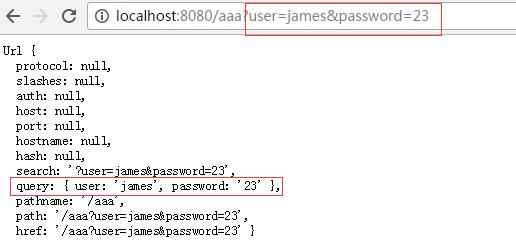GET/POST请求
Posted rogerwu
tags:
篇首语:本文由小常识网(cha138.com)小编为大家整理,主要介绍了GET/POST请求相关的知识,希望对你有一定的参考价值。
获取GET请求内容
由于GET请求直接被嵌入路径中,URL是完整的请求路径,包括了?后面的部分,因此可以手动解析后面的内容作为GET请求的参数
html部分:一个最基本的表单提交
<!DOCTYPE html> <html lang="en"> <head> <meta charset="UTF-8"> <meta name="viewport" content="width=device-width, initial-scale=1.0"> <meta http-equiv="X-UA-Compatible" content="ie=edge"> <title>Document</title> </head> <body> <form action="http://localhost:8080/aaa" method="GET"> 用户名:<input type="text" name="user"><br> 密码:<input type="password" name="password"><br> <input type="submit" value="提交"> </form> </body> </html>
创建一个服务器:
const http = require(\'http\') const url = require(\'url\') const util = require(\'util\') http.createServer( (req, res) => { res.writeHead(200, {\'Content-Type\': \'text/plain; charset=utf-8\'}) res.end(util.inspect(url.parse(req.url, true))) /* url.parse(urlString[, parseQueryString]) urlString: 要解析的URL字符串 parseQueryString: 为true,则返回一个对象;为false,则返回一个未解析的字符串。默认为false */ }).listen(8080)
查看页面返回结果:

在此基础之上,我们也可以获取URL的参数
const http = require(\'http\') const url = require(\'url\') http.createServer( (req, res) => { res.writeHead(200, {\'Content-Type\': \'text/plain; charset=utf-8\'}) // 解析URL参数 let params = url.parse(req.url, true).query res.write(`用户名:${params.user}`) res.write(`\\n`) res.write(`密码:${params.password}`) res.end() }).listen(8080)
查看返回结果:

获取POST请求内容
POST请求的内容全部都在请求体中,http.ServerRequest并没有一个属性内容为请求体,原因是等待请求体传输可能是一件耗时的工作,比如上传文件。
很多时候我们可能并不需要理会请求体的内容,恶意的POST请求会大大消耗服务器的资源,所以Node.js默认是不会解析请求体的,当你需要的时候,需要手动来做
HTML部分:
<!DOCTYPE html> <html lang="en"> <head> <meta charset="UTF-8"> <meta name="viewport" content="width=device-width, initial-scale=1.0"> <meta http-equiv="X-UA-Compatible" content="ie=edge"> <title>Document</title> </head> <body> <form action="http://localhost:8080/aaa" method="POST"> 用户名:<input type="text" name="user"><br> 密码:<input type="password" name="password"><br> <input type="submit" value="提交"> </form> </body> </html>
创建服务器:
const http = require(\'http\') const querystring = require(\'querystring\') const util = require(\'util\') http.createServer( (req, res) => { res.writeHead(200, {\'Content-Type\': \'text/plain; charset: utf-8\'}) let str = \'\' // 用于暂存请求体的信息 // 通过req的data事件监听函数,每当接受到请求体的数据,就累加到str变量里面 req.on(\'data\', function (chunk) { str += chunk }) // 在end事件触发后,通过querystring.parse将str解析为真正的POST请求格式,然后向客户端返回 req.on(\'end\', function () { str = querystring.parse( str ) /* querystring.parse(str[, sep[, eq[, options]]]) 该方法用于将一个查询字符串解析成javascript对象 */ res.end( util.inspect(str) ) }) }).listen(8080)
查看返回结果:

以上是关于GET/POST请求的主要内容,如果未能解决你的问题,请参考以下文章